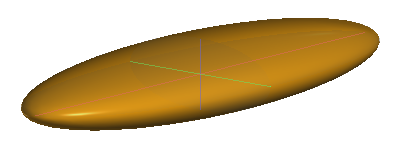Global Trends
The most basic anisotropy tool is the global trend. As the name suggests, this applies the anisotropic trend globally. It is suitable for use in situations where the underlying geology suggests that the anisotropy is planar and continuous over a large area. The global trend sets a constant trend that will favour continuity in one direction. When calculating interpolants and modelling, the application of this global trend will reflect the favouring of the trend direction.
Where an object includes a Trend tab in its settings, you can directly specify the dip, dip azimuth and pitch directions, as well as the maximum, intermediate and minimum ellipsoid ratios. For more information on defining the global trend, see the Setting a Global Trend topic.
The global trend is expressed in the form of ratios in three orthogonal directions, described as the major (“maximum”), semi-major (“intermediate”) and minor (“minimum”) axes of an ellipsoid. When the same value is used for each axis, the ellipsoid is spherical and the global trend is isotropic. Reducing the ratio in the minor axis direction relative to the major and semi-major axes produces an oblate discus-shaped anisotropic trend that de-emphasises the minor axis direction.

This sort of global trend is typical for modelling structures that have undergone compression.
Increasing the ratio value in the major axis direction, while having a lower ratio for the semi-major axis and smaller still for the minor axis further emphasises the trend in the maximum direction.

This sort of global trend is typical for modelling structures formed from flows. When the geology is modelled, the maximum direction of the trend is favoured over the other directions, and the minimum direction is de-emphasised.
When the semi-major and minor axes have the same value and the major axis is larger, this emphasises the trend in only in the maximum direction. This results in a prolate cigar-shaped anisotropic trend.

